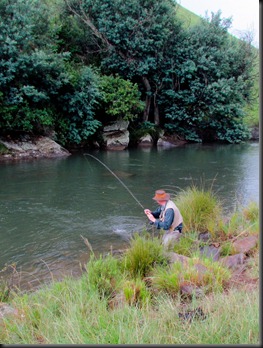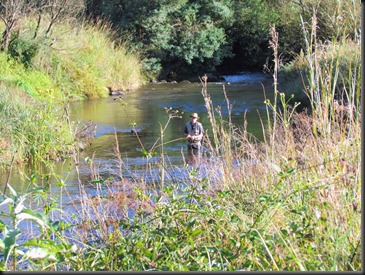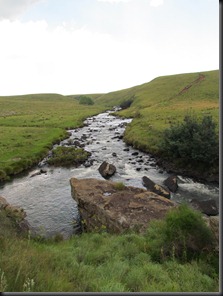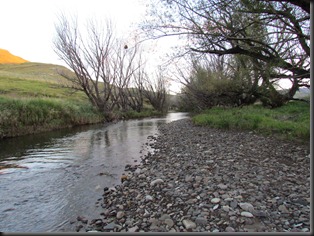Some time back, I fished the Trout Bungalow section of the Mooi River with a good friend of mine. It was a magical April day. We arrived late morning, perhaps a little too late, as I like to be on the water by about 10:00 am at the very latest. We tackled up quickly and headed upstream to do battle.
I carried a particular air about me that day. It was an air of curiosity and comparison. An introspective sense of evaluation, and an acute appreciation of the nature of this river. The reason for this is that the outing was hot on the heals of a visit to Rhodes in the North Eastern Cape.
Now those rivers are unquestionably different. We had done well at Rhodes, and refined our skills a little more. We had adapted to those rivers and moulded our approach around them, and here I was back on home water. Now I was asking myself whether I would fish this river as I had at Rhodes, and if not, why not.
The first observation was that Guy and I remarked on the clarity of the water on the Mooi. It was full, and sparkling, and looking great. However it was not a patch on the clarity of the Bell or the Bokspruit.
Clear water on the Bokspruit at Welgemoed. (Can you spot the Trout?)
It was however still clean by a fisherman’s standards, or by any standards, as no one in their right mind would have described it as “off colour” or “dirty” or anything else other than “clean”. The difference is that a Bokspruit Rainbow at a 10-ft depth would have been able to classify your eye colour if you happened to poke your head more than 6 inches out of the bankside cover. (and very few Bokspruit pools go to 10-ft depth).
The Browns at the Trout bungalow would have difficulty spotting you standing beside their pool, from their deep green depths, and the Mooi on this stretch has many pools that look over 10 ft deep in places. So I think this gave us an advantage on the Mooi.
Paul DeWet lands a Brown on a deep green pool on the Mooi River
I mentioned bank-side cover. As we moved upstream along the banks we were in and out of thick grasses, weeds, shrubs, and all manner of fauna which was waist to chest high. The NE Cape is undoubtedly more stark. The altitude is a contributing factor, but the air is drier up there, and it simply isn’t as humid and lush as the Natal midlands.
This factor alone means that the NE Cape rivers are much easier to fish in. A lot easier, and don’t let anyone tell you otherwise! Once you have managed to master the bank-side vegetation on the Mooi and the Umgeni, and other rivers like them, the Bell or Sterkspruit will be a breeze, from the point of getting your fly out into the flow. However, if you walk up the banks of those Cape rivers as we do on the Mooi, fishing the water at your feet, the fish will run a mile. They will see you coming, due to that clear water, and the less dense cover. So are those rivers really easier after all ?
Mike Kitshoff battling the bankside vegetation of the Umgeni River
I started in on a particular run on the Mooi, where a good pool spills out into a stretch of pocket water. I love to fish this stuff. I waded in a few feet, and very nearly saw my tail on the slippery rocks. The bottom at that point, like anywhere else up and downstream, was strewn with jagged rocks of every different size imaginable. There are very few flattish footfalls on a riffle in the Mooi. Your ankles will be twisted, and your shins tested against sharp rocks all day. Oh for those gentle gravel bars on the middle Sterkspruit!
My fly went out smoothly and I progressively fanned the run with short precise casts, covering all the better looking holes. The indicator bobbed along in the sunshine, and I tracked it eagerly. Not a touch. I moved up a dozed feet at a time, and fanned the water with well-placed casts.
Not a touch.
Had that water been on the lower Bokspruit I would have had a dozen takes at least. Guaranteed!
Right up at the tail of the pool, was a much shallower piece of water. I put one drift over it, using it more as a place to put my line while I moved up between the protruding rocks to tackle the main pool. As I stepped up out of the deeper water into these shallows, a shadow measuring around 20 inches shot out from under my feet.
A few weeks earlier, in a different province, I would have put money on the fact that such a spot would not have held the king of the pool in the absence of a rise, as was the case here. The position of the better fish in the holes, runs and lies was somewhat predictable in the NE Cape. That is a bold statement to make, but it is a well considered one. We had spent days on end there, wading rivers, putting up fish, seeing fish, and catching them. Sometimes it was surprising to see a fish come out of a spot, but invariably one was less surprised after landing the fish, and going in to see how deep that spot was. Deep holes, no matter how small, hold better fish in NE cape waters. Knowing where those holes are, or finding them without walking into them first, was the challenge there.
I went on to fish the main pool without result. My confidence began to flag. Even a heavy nymph, placed right up into the tongue of current where the “littlies” lie, produced nothing.
Not a touch.
I clambered out and moved up to a stretch above the pool. This stretch was not a patch on the pocket water and the pool below. It contained a broad band of light coloured bedrock, which the current swept across. Below this and to the far side, however was some broken riverbed, and it seemed unwise to leave it out.
I clambered back down the bank, and slid into four foot of water. The Mooi runs in a deeper channel than a river like the Sterkspruit. If I had to judge the quantity of water flowing down these two rivers, I reckon it would be ‘much of a muchness’. The Mooi however, consistently runs in a channel that could accommodate two to three times that flow, without it being much wider, or bursting its banks. Not so the Sterkspruit, and others in the Kraai system. So last Sunday on the Mooi, I was acutely aware that I was climbing up and down banks a lot more, and having to do so, as deep pools precluded me from remaining in the river all day as I had done down in the Cape.
The Mooi River in KZN from above Picnic Rock.
Anyway, once in the water I worked my fly over that pale coloured band of rock, and sure enough, after a few casts the indicator slowed slightly as the fly came off the rock shelf. That fish lifted my spirits immensely. It was a glorious Brown with a distinct yellow glow to it, and bold chestnut spots along its flanks. It measured 18 inches, and I believe would have tipped the scales at two and a half pounds.
The two fish that followed were utterly surprising.
Above the shelf of rock, and running down either side of me in the channel, were two tongues of flow tight against the bank. This water was shallow, but it had close cover, and it ran dark and moody against the bank. Nice looking water, I thought. Ideal stuff for a few six to eight inch fish.
Each side of the river produced a sixteen-inch hen. I was off to a very good start!
It so happened that I caught nothing more for the next hour or so, which I spent in a long run of good pocket water. A large pool lower down produced two brownies of 10 inches.
Later in the afternoon the fish began to rise. It often happens on Natal rivers, that the evening rise serves to confirm that there are in fact a lot of fish in the river. I have fished days where I have seriously questioned the fish population, only to be shown up in the late evening, when that same “dead” water positively boils with fish.
On this particular evening they did rise. There were however, not enough fish rising that I could compare the fish population with that of the Bell or Kloppershoekspruit. In my view there were definitely fewer fish. They were however just as spooky in the tails of the pools, and I put a good many down. I did take some fish. I got them on a small DDD as well as a pale Elk Hair Caddis. When it came to the dry fly fishing in the evening, the tactics required of me there on the Mooi, were no different from what I had employed on the Bokspruit, or any other NE Cape river. The issues were the same: working tongues of water for drag free drifts; positioning oneself correctly below the fish; throwing loose leaders; and avoiding lining the fish. I suppose that getting below the fish was generally more difficult, given the depth of water. There were none of those lovely gravel beaches to walk up, and the darkening sky coupled with the unpredictable riverbed made wading treacherous.
Lovely gravel beaches on the Bokspruit
So all told it was a wonderful and memorable time on the Mooi. I suppose I fished it with more thought in view of the comparisons that I drew during the day, and I sense that I did a little better as a result. I think I was a little less lazy on the river than I have been in the past. I spent more effort getting into position in the river, and for whatever reason I waded more . I think the Cape served to remind me that there are fish in all manner of places, and that it is worth putting a fly over them all. On the Mooi this often meant more hard work, and therefore covering less river in the day. But this was a pleasant change, and I am sure I walked past a lot less fish than I usually do.
One thing is for sure: although our regular forays down to the Cape are irreplaceable, us Natalians have world class fishing right on our doorstep.





8 Responses
It’s a pleasure to tour the S. African trout rivers with you. Informative, enlightening. Thanks!
Thank you. The piece is however notable in its omission of the streams of the Western Cape, which are entirely different. I can recommend the blog of Tim Rolston (The Fishing Gene), and the website of Tom Sutcliffe (www.tomsutcliffe.co.za) for excellent information about those waters.
Nice thank you..oh and yes I can see the trout. 🙂
You guys from the Cape have good eyes 🙂
Love your blog. I am a first time visitor but will definitely check back. I lived in SA for a few months back in 04′ and fell in love with the country. I didn’t get to fish at all though. Can’t wait to come back someday.
Thank you for reading.
Nice one Trutta, the Mooi is our gem and the Bushmans. You gotta do that book.
Thanks Roy. The book will come. Maybe when I can shake the day job like you!